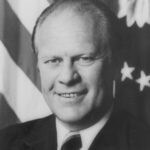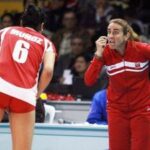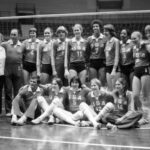Amateur and Olympic sports showcase the most passionate desires of athletes around the world. These athletic endeavors involve hard work, dedication, and perseverance. American amateur and Olympic athletes truly embody the concept of the American Dream. Although it may be hard to believe, these athletes have had to overcome difficult challenges in the past in order to compete in their beloved sport. As the problems of American amateur athletics escalated in the mid 1970’s, Gerald Ford issued the President’s Commission on Olympic Sports. The report analyzed the atmosphere surrounding amateur sports in America, and searched for a potential solution. This report resulted in the Olympic and Amateur Sports Act of 1978 which created cataclysmic change in American amateur sports over the last three decades.
A quick look at the history of Amateur sports in America shows the prominence of two major organizations; the AAU and the NCAA. The AAU resembles a club sport system which is utilized in most countries around the world. In the club sport system, athletes typically join a local club sports team. This system is independent of school related sports and usually takes place after school and on weekends. The United States is the pretty much the only country that has had a school related sports system as successful as the NCAA. The NCAA is something that is very unique to America and it meshes both academics and athletics. These two organizations were both developing into very strong organizations in the mid 1900’s, but neither had total control over amateur athletic sports in America. That is where the problem began.
A heated battle between the AAU and the NCAA started to flare up in the 1960’s and 1970’s. Both organizations wanted to be the official liaison for governing amateur sports in America. In some sports, the AAU was better positioned, while the NCAA held the edge in other sports. The two organizations battled back and forth for control and the athletes were the ones that suffered most. The NCAA would restrict AAU competitors from their national championship competition and the AAU would turn around and do the same (Moore 60). This behavior was not in the nature of amateur sport and certainly did not cultivate the truest form of competition. This became such a big problem that Gerald Ford proposed the President’s Commission on Olympic Sports in 1975 (Moore 61). The two year investigation intensely examined rights of athletes and the roles that the NCAA and AAU were currently playing. After the completion of the investigation, the Olympic and Amateur Sports Act of 1978was enacted.
The Olympic and Amateur Sports Act of 1978 laid out the rules and regulations that shaped amateur sports in the United States from that year forward. In this act, the United States government chartered a monopoly to the USOC (United States Olympic Committee) to head all Olympic and international sport relations. Additionally, the act instituted that each sport showcased in the Olympic Games shall have a governing body that is registered as a 501 c (3) nonprofit institution (Amateur & Olympic Sports Act). This is a fine example of the government assigning responsibility to the nonprofit sector which Stephen Goldsmith and William D. Eggers refer to as “governing by network.”
The United States Olympic Committee is a nonprofit institution whose mission is, “To support Olympic and Paralympic athletes in achieving sustained competitive excellence and preserve the Olympic ideals, and thereby inspire all Americans” (US Olympic Team). The USOC acts as a headquarters for all American amateur and Olympic sports. They are the designated organization that is to deal with the International Olympic Committee, the World Anti Doping Agency, and all other world sport organizations. The hope was to have one nonprofit organization that would be in charge of all international amateur sport relations, rather than two fighting with their own desires.
As mentioned earlier, each Olympic sport has a national governing body. These nonprofit institutions have roles that are spelled out for them in the Olympic and Amateur Sports Act. Each national governing body is responsible for establishing national goals for the sport and serves as the coordinating body for that sport in the United States. This includes conducting competitions, selecting and fielding teams to represent the United States in international competition; and providing coaching and training for the athletes of their sport. Additionally, these national governing bodies aim to develop an interest in their sport in the United States and encourage participation by women in their sport (Amateur & Olympic Sports Act). Both national governing bodies and the USOC are 501 c (3) nonprofit institutions that focus on the betterment of amateur sports in America. Additionally, these organizations are designed to showcase America’s amateur athletes and provide inspiration to all Americans. Therefore, monetary gifts to these organizations are tax deductible.
This leads to a discussion of the legal and regulatory constraints in amateur sports in the United States. The Olympic and Amateur Sports Act of 1978 outlined the guidelines to be followed in the United States in regards to amateur sports. It established the USOC as the head governing body of amateur sports, and created national governing bodies to govern each individual sport (Amateur & Olympic Sports Act). Each institution in this system answers or reports to someone and must comply with other organizations. This structure allows for checks and balances within the amateur sports world. No one single organization has the complete total control over what is said and done in a sport. Everyone gets their say, but they must comply with some rules and regulations from other agencies along the way.
The USOC is required to file a report to the United States government every four years detailing their accomplishments, expenditures, and data concerning the steps take to encourage women and disabled athletes (Amateur & Olympic Sports Act). Additionally, this report is to be made available to the public. The USOC must also comply with the International Olympic Committee, and the World Anti Doping Agency. National governing bodies have freedom to operate on their own, but they are closely watched by the USOC. These national governing bodies must also comply with world governing agencies of their sport. The actions of national governing bodies are also closely kept in line by the eye of the public. There is a section of the Olympic & Amateur Sports Act that states that national governing bodies of sport can be replaced by other agencies if they do not perform in a satisfactory manner. Finally, all amateur and Olympic sport agencies must comply with the guidelines and regulations that were outlined in the Olympic and Amateur Sports Act of 1978.
There are thirty-nine national governing bodies of sport in the United States. Thirty-one of these national governing bodies govern Summer Olympic sports while eight govern Winter Olympic sports (US Olympic Team). While these national governing bodies are independent nonprofit institutions, they must also report to the USOC. In turn, the USOC provides financial support to both the national governing bodies and individual athletes. During 2004, the year of the Summer Olympics in Athens, the USOC gave $50 million to national governing bodies in the form of member support. This member support includes financial assistance to athletes, and grants to national governing bodies for support and oversight. Also in 2004, the USOC dispersed $4 million to send United States competitors and coaches to international competitions. Finally, $23 million was spent on Olympic training centers in the form of room and board for athletes, training facilities, coaching, and sports medicine (United States Olympic Committee).
While the USOC makes an ample effort to aid and provide oversight to the national governing bodies and the athletes that compete for them, these national governing bodies are still independent organizations. Some national governing bodies are extremely organized business like organizations while others appear unorganized, lack revenue streams, and do not have enough money to support their operations year round. This is clearly evident when one looks at the budgets of each national governing body. Some national governing bodies get a small 4.5% of their annual funding from the USOC. Yet, others are heavily dependent on the USOC, receiving over 70% of their annual budget from these grants (Borzilleri).
A quick look at two national governing bodies will reveal how much difference there can actually be between national governing bodies of sport. The USATF (United States Track & Field) is an Indianapolis based nonprofit that is the governing body of Track & Field and long distance running. They are one of the more successful national governing bodies of sport in the United States. The USATF has doubled its revenue since 1997 and become much more involved in the community (USA Track & Field). One of the main reasons the USATF is so successful is because they have very little expenses in training and developing their athletes. The NCAA acts as a feeder system and four year training school for most of the USATF athletes. Additionally, most USATF athletes train at colleges, or local tracks. Since the USATF does not have to focus on training their athletes, they can focus on other business ventures. Because of their organized business like structure, they are able to focus on finding sponsors and partners, serving their 100,000 members, and creating additional revenue streams (Greer). This allows the USATF to focus additional revenue streams and become less dependent on the USOC grants.
The USBSF (United States Bobsled and Skeleton Federation) is the governing body of bobsledding, and skeleton. Typically, Winter Olympic sports have a much more difficult time with supporting their sport. The following in the United States is low and Winter Olympic sports are often much more expensive than Summer Olympic sports. That is certainly the case in this instance. The USBSF is a national governing body does not have many partnerships, sponsors, or revenue streams. However, the sport is very expensive. For instance, the bobsled track at the 2006 Winter Olympics in Torino cost $83 million to construct (Clarey). In addition to high facility and equipment costs, the USBSF has a high cost of developing athletes. In order to conduct proper training, the USBSF pays for housing, meals, and travel expenses of its athletes while at the training center. Because the cost is so great, the USBSF typically only conducts training five to seven months out of the year (Kummer). The USBSF is a prime example of a national governing body that does not have many sponsors, and is heavily reliant on funding from the USOC.
A major concern for the smaller and less developed national governing bodies has been the influence that the USOC has over their operations. In the past year, the USOC has undergone studies on each national governing body in terms of their management structure, operational efficiency, and potential to generate revenue. Based on those reports, the USOC board made decisions to withhold or cut funding from certain governing bodies (Borzilleri). The USBSF was one of the national governing bodies that received a cut in their annual budget. In order to deal with this budge cut, the USBSF had to cut three weeks out of their funded athlete training schedule (Sprague). Needless to say, these smaller national governing bodies that do not generate much revenue may be under the greatest scrutiny and have the most pressure of any type of amateur sports organization.
There are a lot of major challenges set before the amateur and Olympic sports agencies in America. One of the biggest challenges is defining what the role of each organization is in relation to the bigger whole. One of the first questions needed to be answered is; “Should the USOC simply be a fundraiser that supports these national governing bodies of sport, or should the USOC be the head agency for dealing with amateur sports that has many different smaller departments?” Finding answer to this question will allow for a healthier development of amateur sports in America in the future.
A second situation that needs to be addressed is the treatment of sports and national governing bodies that do not generate much revenue. Some of these sports may be able to be turned into revenue generating organizations with management changes. However, some of these sports are likely to have very little financial success. Does America want to keep funding these sports even though they may be costly and bring in very little revenue? Deciding how to treat these sports and their national governing bodies will be a challenge for the USOC and amateur sports in America.
The overall effect of the Olympic and Amateur Sports Act of 1978 has been very good for amateur sports in America. The power struggle between the NCAA and the AAU has been subdued and amateur sports organizations have proven to be more successful when working together. The system that is currently used is much more efficient and has been very productive in its existence over the past three decades. The United States has continued to win more and more medals than ever at the Summer and Winter Olympic Games. In the 2004 Athens Summer Olympics, the United States won 109 total medals, which was 39 more medals than China; the country with the second most medals. In the 2006 Torino Winter Olympics, the United States won more medals than they ever have at a Winter Olympics with 25 medals. This was second behind Germany, who had 29 medals (US Olympic Team).
As defined by the Olympic and Amateur Sports Act of 1978, the role of the USOC, and the national governing bodies is to promote amateur athletics, increase awareness of amateur athletics, and in turn inspire all Americans. It seems that this new system of governing amateur Olympic sports in America has done just what it was intended to do. The system is not perfect, and will continue to be molded and shaped with time as new needs develop. As the role of each institution begins to become more clear in the future, the United States will see even greater progress in the development of their amateur sports programs. The constant refining and tweaking of this process is what will allow the United States to continue to develop medal winners at the Summer and Winter Olympic Games.



